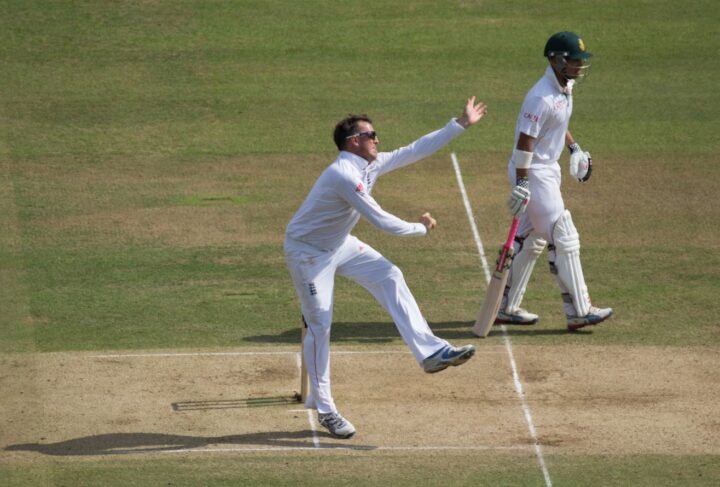As one shifts from commercial art to literary fiction, they are greeted by increasingly ambiguous endings. After all, when a plot unravels in the subtext rather than on the surface level, how can one expect ‘blockbuster’ climaxes in the truest sense of our modern understanding?
To stretch the analogy beyond its natural limit, Test cricket’s followers might just form the ‘literary circle’ of the sporting world. There doesn’t seem to be much going on at any time when one tunes into the format. If a person more inclined towards white-ball cricket were to give it a go, they’ll be forgiven for saying, “Why, I heard Rohit Sharma copies the postures of the divine for fun while scoring double centuries in ODI cricket. But here, he’s been leaving the ball outside off for the past half hour!”
Rohit’s transformation in the Test series against England might be one of the most astonishing cricketing stories coming out of the elite level in the recent past. He’s a naturally aggressive player who thrives on minimal movement. It’s not because he has any inherent deficiencies in his technique, but because he has learnt to maximise opportunities as an ODI opener in an era of flat pitches. He’s the batter’s equivalent of a novelist with the ability to execute elegant turns of phrases in the middle of a thriller. When you’re as successful as you are working within the confines of a genre with a fixed template, why would you risk your hand at crafting a devastating magnum opus that might have not have a coherent plot, but still presents a world of greater beauty than your previous works could ever conjure?
Either way, he’s done exactly that. He now returns to the more familiar terrains of the IPL with his name on The Oval honours board for scoring a second-innings century in the fourth Test. It was the only time he crossed triple figures since landing on English shores for the World Test Championship final, but his overall numbers speak of a consistency not many would have expected from him in these conditions.
In eight innings while fronting up a side past openers have perennially underachieved against, he scored 368 runs at an average of 52.75. What’s even more illustrative is the strike rate at which he’s compiled these runs (42.49). It’s indicative of a writer shifting from writing regular airport paperbacks about Cold War espionage and becoming more of a, err, John le Carré.
The conflict was often internal whenever he came out to bat against England’s devastating new-ball pair. There was a considerable amount of luck involved in the lengthy periods the two Indian openers survived out in the middle. But good fortune has always been there for the protagonist who keeps his head low and survives a winter that’s a metaphor for the loss of his innocence, and the Test batter who shows the necessary will to survive in tough conditions.
The going never gets ‘easy’ while batting in the UK in the way one might expect it to on friendlier pitches. This was reflective in the manner all batters barring Joe Root never seemed truly settled at the crease during England’s home summer. Sharma was often the victim of his own adventurous strokes, but as Jarrod Kimber convincingly explained in the aftermath of his dismissal off Nathan Lyon during the series Down Under, it’s the part of his new approach to red-ball bating.
It’s a wonder why Sharma took as long as he did to score his maiden red-ball ton outside the subcontinent. At the same, it isn’t. Anyone who’s seen him knows he will go down as one of the greatest LOI batters of all time even if never gets to play another international innings in his life. But the fact that he was willing to further tune his technique to suit the swing and seam of English conditions shows that there is something about the format of the game that remains the pinnacle for everyone involved.
There have been lots of discussions and heated debates about the priority of Test cricket in the new world order. Is it a viable product for the newer generations? Is its quality being decreased by the evolution of the other formats being played alongside it? And most importantly, IS THE IPL BEHIND CLIMATE CHANGE, CAUSING SUCH GLOBAL POLITICAL INSTABILITY, AND A SCHEME OF THE ILLUMINATI?
There are no objective answers one can provide to such inherently subjective questions. But as a fan who follows multiple formats with the same passion – no matter how taxing such an endeavour might have proven to be in recent times – I can assure those willing to listen that all formats are good for the purposes they serve.
Just like most modern movie-goers prefer a Marvelesque film that provides a short burst of adrenaline aided by mildly witty characters and explosive set pieces, most modern cricket fans prefer the hubbub of white-ball cricket. There is nothing wrong with the entrance of such fans entering the sport who seek momentary pleasure from it. Many IPL fans provide the perfect template for such a phenomenon – once the tournament is over, they return to their normal lives with no idea about how their nation might be faring in the sport barring major events. After all, if someone liked watching Tom Hiddleston portray the role of Loki in the MCU, it doesn’t mean they’re willing to plunge the depths of the Internet just to watch him in High-Rise.
Similarly, you can’t fault those who prefer a deeper connection with the game of cricket, as Test cricket provides the avenue for. The meandering nature of willow-and-leather-induced combat on 22 yards across five days is as romantic as sports can get. In my opinion, there is no higher form of pleasure to be found from this domain as long as both sides play with integrity and on good pitches.
But is it not true that more often than not, the subtext of game us ardent fans of the game are aware of doesn’t reach most fans of white-ball cricket? It is the responsibility of the governing bodies to do the best they can – and the ECB has failed terribly in discharging these duties even as they fill their pockets. They should be the ones being called out for the mistreatment of the game, not the formats that comprise the on-field action.
This explicit contrast between ‘high art’ and ‘low art’ also shouldn’t excuse the snobbery of those who think Test cricket is the only format that deserves the spotlight to a wider audience. Neither can I see the need for many IPL fans to tag Cheteshwar Pujara as a ‘bore’ every time he plays out a string of maidens in difficult conditions.
The T20 format provides more monetary incentive for players to engage with it. If we eliminate the nationalistic rhetoric from the conversation, who can fault sportspeople for choosing a bigger paycheque compared to an Ashes series that will inevitably be accompanied by overtly jingoistic critics in the press boxes and armchairs from both sides of the aisle? Throw in the complications of living in ‘bubbles’ and contractual commitments to such a rigorous international calendar, and you have a clearer picture of why there are no clear answers to be found if fans continue to debate with each other based on these zero-sum arguments of ‘Test v T20 Cricket’.
To round things off with the most explicit invocation of the analogy I’ve been using throughout this piece, we see a similar debate arise between those who publish commercial novels and those who make a more modest living by writing literary fiction. The search for the ‘superior’ doesn’t do any good except increasing the opacity of the veil draped around figures in capitalist establishments. They’re the ones that need to be held accountable both within dressing rooms and across the globe.
The fact that the IPL was such an integral part of the controversy surrounding the cancellation/postponement/bureaucratisation of the fifth Test shows how ambiguous nothings and flashier arguments can never be separated from each other. It is the duty of the thinking fan to lend a moment of thought to each side of the argument before devoting one’s stronger emotions to a particular stance. It brings more empathy into public discourse and widens our horizons of interaction with different agents within the game.
Acclimatising oneself to contemporary culture’s chaos is no easy task. But if we manage to do so in our little ways, we will be rewarded with the beauty of diversity on a scale much grander than our preconceived notions.
Just ask Rohit Sharma. He’s provided us with an unlikely template of how we can traverse between the genres and formats in a life of surplus by taking a plunge of faith. A successful pull off his willow remains as exquisite as a witty turn of phrase – be it in an IPL match or the first session of an English Test; be it in a Marvel movie or a Scorsese classic.
Abhijato Sensarma









Interesting but I find this a little above my more simple train of thought on the game. The writer seems, I think, to be saying we should celebrate the fact that Rohit can adapt to all formats of the game more than most other batsmen. We yes he can, but equally so can Root, Kohli, Williamson, Stokes and a variety of a few lesser known county batsmen. I wouldn’t call this “diversity” a term used to quantify a whole host of issues anymore than “batters”, “thirds” or “nightwatchers” (blimey that one takes the biscuit). The issue white ball vs red ball is a bit like trying to compare McDonald’s with Gordon Ramsey al a carte, but more importantly, the issue how the obsession with it is destroying County Cricket and infecting Test Cricket around the World. The 100? No, the great game needs saving not being bastardised for the instant society and lining Tom Harrison’s pockets.
Take a look at the last two rounds of County 4 Day Matches: the amount of all outs under 150 was staggering. In decades of cricket watching the standard of County Championship cricket, and particularly England Test Cricket, is undoubtedly the worst I’ve ever seen.
Re the last point: my county Hampshire got criticised by the visiting captain for producing an “unacceptable” pitch. The great crime was that the pitch turned. The home side managed to make 400 runs on it despite having a less than vintage batting line-up. Hampshire’s previous match had seen 20 wickets fall on Day One to seamers at Edgbaston with neither complaint nor action resulting that I’ve noticed.
It’s all pretty useless to producing a Test team of course (at least until Tests are played in September on pitches that make Darren Stevens look like Malcolm Marshall – which may not be too far off as it happens but that’s another thing). However as counties must suspect at this time of year that the weather may remove a chunk of the playing, is anyone surprised this is happening? And does anyone in officialdom care?
One solution to the overall balance problem that has been advocated endless times is to scrap bilateral T20s. Keep International T20s for the WC and otherwise leave to domestic tournaments. Nevetheless there isn’t a sign it’s going to happen.
The fundamental problem is that those running the game don’t see T10, the 16.66 or T20 as gateways into the longer form. They see them as ends in themselves and their preferred form. Ian Chappell warned a decade ago this was the attitude he was hearing from administrators and he wasn’t wrong.
I’ve always said that cricket, because of the time spent to play matches reflects the times it’s being played in better than any other sport. So I’ve never had issues with white ball. What I have issues with is the attitude of the administrators in their denial of red ball popularity, especially test cricket, in comparison to the one day game. The Old Trafford test would have sold close to 100,000 tickets had it gone 5 days. The entire Hundred, even with its extravagant publicity sold less than 500,000 tickets over 34 matches. That doesn’t sit with the Harrison comments. The increasingly ridiculous schedules will continue to take their toll on players well being and burn out will become common.
There has to be a better balance struck, but we need administrators with a respect for the game and its supporters rather than ego tripping marketing men for whom the cash cow is king.
Abhijato Sensarma’s article is a thought-provoking and interesting contribution to the debate. I have just finished reading Ramachandra Guha’s “The Commonwealth of Cricket” which discusses some of the same issues but from the point of view of a lover of the longer form of the game.
What I liked about Mr Sensarma’s article was the wish to respect all forms of the game. I prefer Tests and the County Championship but watch the other forms. My main worry is we are just trying to play too much Cricket which cannot be good for the players.
Mr Hall, people have been recommending me this book for quite some time! I’ll take your comment to be the final hint for me to give in to readings this particular work from an accomplished historian.
Rainford-Brent has an article in the Guardian about player burnout and the schedule needing reform (although she’s short on specifics).
This, and various other rumblings, suggest to me that we may be being prepped for an Ashes between 2nd XIs.
Seems like he’s on our side – and of course the criticisms of the ECB are well if easily made:
https://www.theguardian.com/sport/2021/sep/25/after-25-years-of-the-suits-is-the-spinning-self-interested-ecb-still-fit-for-purpose
What, however, does he want to replace it? He seems to be prepping the way for a complete franchise model takeover of the game and the demise of the international sport. It’s somewhat obfuscated but that’s what I think he’s pointing to in the final paragraphs.
I think he’s saying that it might happen but I don’t read the article at all as saying that he’s in favour of it–the whole tenor of the piece suggests that he thinks it would be at least as bad, possibly worse and essentially the same.
Anduril is the reforged Narsil, and is used by Aragorn, anduril sword King of Gondor. The inscription down the length of the blade on both sides in the Middle-Earth language of Quenya, written in the runes of Eregion, ” This translates to “I am Anduril who was Narsil, the sword of Elendil. Let the thralls of Mordor flee me.